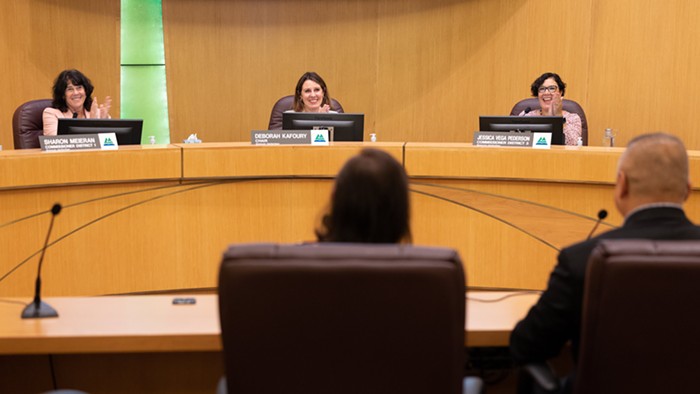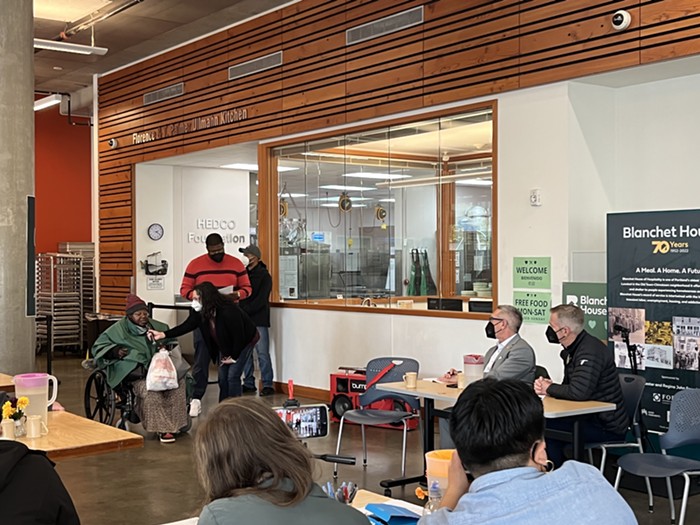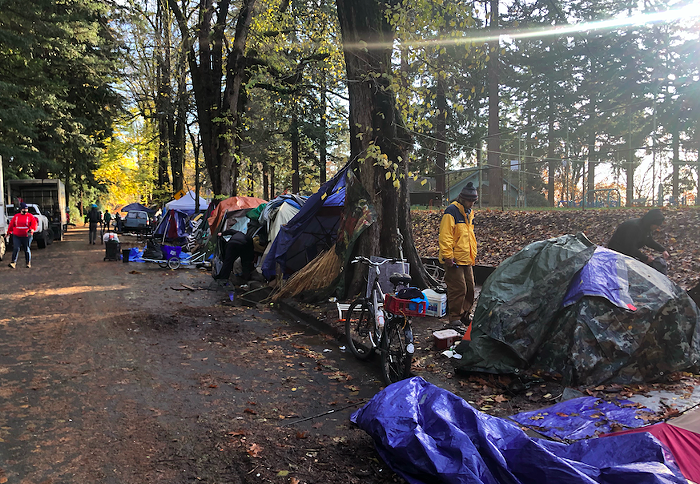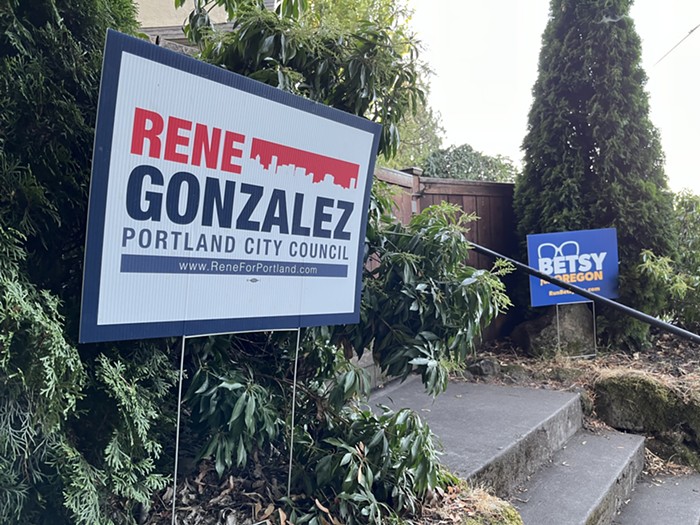
In Multnomah County, the predicted “wave of evictions” expected to follow the end of Oregon’s COVID-19 eviction moratorium has begun to crest.
The state’s moratorium expired on June 30. In the month of July, Multnomah County saw 109 eviction notices for tenants due to unpaid rent, according to data collected by the Oregon Law Center. During the first half of 2021—while the moratorium was still in place—the county court saw a monthly average of 16 eviction filings due to nonpayment. That’s nearly a sevenfold increase.
During an August 3 court hearing, a tenant facing eviction for nonpayment called in to defend his case. (In eviction court, tenants aren’t offered public defenders to represent them, despite them often going up against their landlords’ experienced attorneys.) The tenant explained to Judge Mark Peterson that he was planning on paying his missed rent to his landlord within three days. Peterson approved of this agreement, and gave the renter a date and time to return to his court to formally close the case.
The renter thanked Peterson—then said he had one more question.
“I keep getting mail from lawyers saying that if I sign up for something there will be a stay on my eviction for 60 days,” the renter said. “Is that a real thing—or is that just junk mail?”
Peterson declined to answer, citing that he can’t give legal advice.
His response was interrupted by an anonymous attendee in the courtroom’s public video call: “It’s a real thing, yes! It’s 90 days! Apply for it!” Peterson cut the speaker off, scolded them for interjecting, and ended the hearing.
The speaker was referring to a county policy introduced in July, which extends a state law to protect Multnomah County tenants from eviction for up to 90 days, if they can show their landlord that they’ve applied for rent assistance.
The renter’s confusion exemplifies what thousands of tenants are experiencing on the heels of the moratorium. As eviction notices begin to appear on doors across Portland, few tenants are aware of what well-funded protections currently exist for them. Those who have applied for assistance, meanwhile, have been undermined by a hastily-constructed state system processing rental assistance applications at a glacial pace. Despite having more than a year to prepare for this critical moment, government agencies are scrambling to meet the needs of renters stripped of financial security during the pandemic. The process has brought newfound attention to longtime problems baked into an eviction system that overlooks renter’s rights.
“I can’t sleep...I’m afraid to go to my mailbox. I’m afraid to come home and see an eviction notice on my door.”
Oregon’s first eviction moratorium due to COVID-19 was put in place on March 22, 2020. As the pandemic plodded along, the state continued to extend the moratorium’s end date, eventually setting it to expire on June 30, 2021. Renters have until February 29, 2022 to pay their landlords for rent they skipped during the moratorium. Then there’s the “safe harbor” law: an Oregon bill passed in late June that safeguards tenants from eviction for 60 days, as long as the tenant can show their landlord proof that they’ve applied for rent assistance to cover missed payments.
The law was meant to address a growing slowdown within the Oregon Emergency Rental Assistance Program, the state’s system tasked with distributing $204 million in federal funds reserved for rental assistance. The program, overseen by Oregon Housing and Community Services (OHCS), was built around a new software program called Allita, which was meant to efficiently streamline the process of distributing the federal rental aid dollars at the state level. But, due to the Allita system’s glitches and inconsistent training for agencies relying on the new program, financial support wasn’t getting to those who needed it quickly enough.
The state began taking applications through Allita on May 19. Currently, only 14 percent of all 25,000 Oregon households that have applied for rental assistance through the Allita-run online portal have been approved to receive funds. It’s even worse in Multnomah County, where the state has seen the largest need for rent assistance. According to the state’s data, only 2.5 percent of the 8,900 Multnomah County households who’ve asked for rent assistance have been approved for funding. A week after the state passed it’s 60-day safe harbor bill, Multnomah County passed a provision extending that eviction protection period to 90 days.
Portlander Jeane Gaiennie was quick to apply to the state’s rental assistance program on May 19. Gaiennie, 58, hadn’t been able to pay rent at her NE Sandy studio apartment for the past three months, and she was eager to get to the top of the intake list. Gaiennie set her alarm clock early to submit her information right when the online portal began taking submissions at 6 am.
Yet, almost three months later, Gaiennie hasn’t received a response, let alone financial aid.
“When I check online, my application is still marked as ‘pending,’” said Gaiennie, who’s since missed June, July, and August rents. When she’s called her landlord to see if they’ve received any payments, she’s been accused of harassment. Gaiennie, who owes $7,000 in unpaid rent, worries that she won’t get the financial assistance she applied for before her 90-day grace period runs out.
“I’m afraid to call them anymore. But it’s overwhelming not knowing where I stand,” Gaiennie said. “I can’t sleep...I’m afraid to go to my mailbox. I’m afraid to come home and see an eviction notice on my door.”
She’s one of an estimated 8,100 county residents left in wait.
The slow rollout of state dollars has impacted local property owners as well as tenants. Mike Havlik, the deputy director of landlord advocacy organization Multifamily NW, said that area landlords are relying on their tenants’ rent assistance to pay their own bills after months of deferred rent payments.
Havlik said landlords are already familiar with the problems riddling the Allita system, as it’s how the state’s Landlord Compensation Fund has been administered. The fund, which offers to pay landlords 80 percent of rent they’ve lost during the eviction moratorium, as long as they forgive the remaining 20 percent, has faced similar distribution delays. According to OHCS’ own data, only 24 percent of the fund has been distributed to Multnomah County landlords since the state began receiving applications in February.

Property owners have grown frustrated by the multiple delays, knowing how much federal money has been distributed to Oregon to address the crisis.
“Based on the amount of rental assistance available, we don’t believe anybody should have to be evicted,” said Havlik.
According to Peggy Samolinski, director of Multnomah County’s Youth and Family Services, OHCS didn’t train county employees on how to use the Allita system until after the rental assistance program went live on May 19.
“Because it was a brand new system, everyone was learning at the same time,” said Samolinski, who is in charge of distributing the state’s rental assistance funds at the county level.
Since it went live in May, the state system has distributed $1.2 million in rent assistance to 224 households in Multnomah County. But Allita isn’t the only way local renters are accessing help with rent payments.
Samolinski contrasted the efficacy of the Allita system to Multnomah County’s decades-old rent assistance program, which has also been processing requests throughout the pandemic. The county and city of Portland were given a combined $55 million in federal funds specifically for rent assistance, which they’ve been dispersing through requests made to 2-1-1 and partnerships with more than 40 community nonprofits that work closely with tenant communities. In the month of July, the local program was able to support 29 households with a total $53,000 in rent assistance. Samolinski said the process of getting rent checks in the hands of those who apply has taken, on average, five days. In comparison, renters like Gaiennie who have applied for rent through Allitta have been waiting nearly three months for a check.
The state knows its chosen program to distribute rental assistance is problematic.
“The Allita system is not perfect,” said Connor McDonnell, a spokesperson for Oregon Housing and Community Service (OHCS), in an email to the Mercury. “The back end of the system can also be glitchy which is frustrating for those processing applications.”
In late July, OHCS realized it wouldn’t be able to process all rent assistance applications for renters living in the Portland metro region within the 90-day grace period (or, for those not living in Multnomah County, 60-day), and announced a plan to hire an outside vendor to help fast-track applications. The plan will increase the number of staff processing applications in the Portland metro region by at least 60 people, which the state estimates could process between 7,000 and 8,500 applications.
McDonnell said that the state did not expect to intervene in county-level rental assistance work.
“To be clear, this is not a role OHCS anticipated taking even as soon as May,” said McDonnell. “We’re doing everything in our power to serve Oregonians in need.”
McDonnell said the state is “not tied” to Allita and is “exploring other options” to purchase with an expected installment of $156 million in federal funding coming to the state later this year.
Yet the state is confident that with its newly expanded staff, it will be able to disperse rental aid in time to meet tenants’ needs.
While a healthy amount of federal aid may exist for local renters on the edge of eviction, not all tenants are aware of the safety nets in place to keep them housed.
“Most renters are under the impression that fighting the eviction is a lost cause, essentially.”
Volunteers with local tenant’s rights group Portland Tenants United (PTU) have spent the past two weeks visiting Multnomah County renters who’ve received eviction notices for nonpayment of rent to make sure they’re aware of the current state and local protections. PTU’s address data, combed from the court docket, shows that the majority of properties threatened with eviction are located in far East Portland and Gresham.
PTU organizer Alli Sayre said that most people she’s spoken with haven’t heard of the current laws granting them a buffer from evictions.
“Most did not even know about rental assistance,” said Sayre. “Most are under the impression that [fighting the eviction] is a lost cause, essentially.”
Sayre said that those tenants who are aware of the 90-day protection have cited other barriers that have kept them from applying for rent assistance, like trouble getting a copy of their lease from their landlord,and tracking down other required documentation. Sayre believes the policy has further complicated the process for already-stressed tenants.
“It doesn’t make any sense why the state wouldn’t extend the [eviction] moratorium at this point, especially if [rental assistance] applications aren’t being processed,” Sayre said. “They’re creating this false time crunch… and it’s clearly backfiring.”
The county is also hoping to reach tenants at risk of eviction who might not know about the current eviction prevention options by contracting with Oregon Law Center, a legal aid organization with a long history of defending low-income Portlanders. Like PTU, attorneys with Oregon Law Center have been pulling addresses from the eviction court docket and mailing tenants information about the state and county’s rental assistance program and information on legal aid.
Becky Straus, an Oregon Law Center attorney, said she wasn’t surprised to see the surge of nonpayment evictions landlords filed in July. What’s important, Straus stressed, is that renters know these eviction proceedings can be stopped by submitting applications for rental support.
“If tenants aren’t aware of their rights, we’ll see these evictions moving through rapidly… this is a quick process,” said Straus. “But it’s preventable right now.”
County officials say they’d prefer if renters knew to apply for aid before getting hit with an eviction notice. But, because the eviction process is much swifter than the county’s ability to educate tenants about the protections, county staff have been forced to address the issue when it’s already reached its boiling point.
Since July 30, case workers with Bienestar de la Familia, a division of Multnomah County's Department of Human Services, have been visiting the Multnomah County Courthouse during scheduled eviction hearings, in hopes of interfering.

Raquel Aguillón, a supervisor with Bienestar, said case workers are trying to intercept tenants who are facing eviction for nonpayment before their first appearance in court and help them fill out rent assistance forms to present to their landlord—which would effectively dismiss the case.
“Knowing the urgency of evictions right now, we’re all working as fast as possible,” said Aguillón.
They’ve already been able to prevent a number of evictions by being on scene to assist. For the county, the process has provided a firsthand view on the critical gaps in the eviction system. Samolinski said it has her team brainstorming ways to offer some kind of public service announcement to tenants across the region who may not know about the county’s rental assistance. It’s the lack of information about tenants’ rights that has landed so many residents in eviction court this past month, she said.
“It’s got us thinking, ‘How can we connect with those folks in the long run?’” Samonlinski said.
County spokesperson Denis Therauilt said the answer to this question is already in the works. Staff are currently fine-tuning a proposal to reach “as many people as possible” in Multnomah County through text alerts or postcards to educate tenants on what to do if they receive an eviction notice. The program, which has yet to get leadership’s approval, was inspired by county staff’s experience working with tenants during the pandemic.
“We can see this work as a road map to how we change our response to housing insecurity for renters.”
Straus, with the Oregon Law Center, said this crisis offers an opportunity to more broadly rethink the way public agencies support Portlanders faced with eviction.
“We can see this work as a road map to how we change our response to housing insecurity for renters,” said Straus. “I think this idea of very resourced outreach to tenants and creative interventions in their case should be a model long after we’re done with pandemic protections. It should be something built into the court process.”
That could mean permanently having rent assistance and legal aid offered at the courthouse for tenants facing eviction court.
This is work that Portland’s Rental Service Office (RSO) has been gearing up to provide. The RSO was created in 2019 to offer tenants resources to fight evictions or better understand their rights, but rarely has enough funding to do more than provide useful links to renters. Last week, Portland City Council voted to use $440,000 in federal relief funding to set up a Right to Counsel Program within the RSO. The program, which is still being developed, will cover legal representation for low-income tenants facing eviction. While the program only has funding for a year’s work, the city will consider renewal in 2022.
PTU and other renters’ rights groups have advocated for this kind of guaranteed legal representation for years. Sayre said that, if anything, the current crisis facing renters at the tail-end of the eviction moratorium should be enough evidence to prove why free legal counsel should be considered a standard right for any tenant.
“We’re talking about people who have fallen through the cracks, who the system has let down,” said Sayre. “We need to respond with urgency.”



















